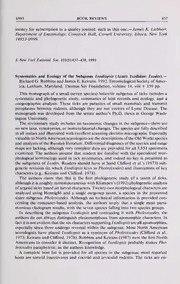
Systematics and Ecology of the Subgenus Ixodiopsis (Acari: Ixodidae: Ixodes) by Richard G. Robbins, James E. Keirans PDF
Preview Systematics and Ecology of the Subgenus Ixodiopsis (Acari: Ixodidae: Ixodes) by Richard G. Robbins, James E. Keirans
1993 BOOK REVIEWS 437 money for subscription to a qualityjournal, such as this one.—James K. Liebherr, Department ofEntomology, Comstock Hall, Cornell University, Ithaca, New York 14853-0999. J. New YorkEntomol. Soc. 101(3):437-438, 1993 Systematics and Ecology of the Subgenus Ixodiopsis (Acari: Ixodidae: Ixodes).— RichardG. RobbinsandJames E. Keirans. 1992. EntomologicalSocietyofAmer- ica, Lanham, Maryland. Thomas Say Foundation, volume 14, viii +159 pp. This monograph ofa small (seven species) holarctic subgenus ofticks includes a systematic and phylogenetic study, summaries of host records and ecology, and a zoogeographic analysis. These ticks are parasites of small mammals and transmit piroplasms between rodents, although they are not vectors of Lyme Disease. The monograph was developed from the senior author’s Ph.D. thesis at George Wash- ington University. The revisionary study includes no taxonomic changes in the subgenus—there are nonewtaxa, synonymies, ornomenclatorialchanges. The speciesare fullydescribed inall instarsand illustratedwithexcellent scanningelectron micrographs. Especially valuabletoNorthAmericanacarologistsarethedescriptionsoftheOldWorldspecies andanalysesofthe Russianliterature. Differentialdiagnosesofthespeciesandrange maps are lacking, although very complete data are provided forall 3,851 specimens examined. The authors assume that readers are familiar with the specialized mor- phological terminology used in tick systematics, and indeed no key is presented to the subgenera ofIxodes. Readers should have at hand Clifford et al.’s (1973) sub- generic revision (in which Ixodiopsis keys to Pholeoixodes) and illustrations ofkey characters (e.g., Keirans and Clifford, 1978). The authors claim that this is the first phylogenetic study of a taxon of ticks, althoughitisroughlycontemporaneouswithKlompen’s(1992)phylogeneticanalysis ofargasidticksbasedon larvalcharacters. Twenty-two morphologicalcharactersare analyzed using Hennig86 and a single outgroup taxon, a species in the presumed sister subgenus Pholeoixodes. Although no technical information is provided con- cerning the computer-based analysis, the authors imply that a single most parsi- monious cladogram results, with the seven species falling into two species groups. In describing the subgenus Ixodiopsis and contrasting it with Pholeoixodes, the authors do not always distinguish plesiomorphous from apomorphic characters. In factitisnotevidentthatthesixcharacterssupportingIxodiopsisareallapomorphies, especially since three undergo reversal within the subgenus. Most North American acarologists have placed Ixodiopsis as a synonym ofPholeoixodes (Clifford et al., 1973; Keirans and Clifford, 1978). Robbins and Keirans (1987) were the first North Americans to consider it distinct. Recognition of Ixodiopsis probably makes Pho- leoixodes paraphyletic, as the authors knowledge. A complete host list is provided for all species in the subgenus; most reported hosts are soricid insectivores and cricetid and arvicolid rodents. The ticks are en- 438 JOURNALOFTHE NEWYORK ENTOMOLOGICALSOCIETY Vol. 101(3) dophilic, completing their life cycles in host nests, and most species have restricted host rangesand occuronly in cool moistclimates. Theexception is Ixodesangustus, the only holarctic species, which iscommon on a wide variety ofhosts. The authors hypothesize that I. angustus is similar to the ancestral Ixodiopsis, although their phylogenetic analysis actually places it at the tip ofone ofthe two clades. Thechapterofgreatestinteresttonon-tick-specialistsconcernszoogeography.The authors present an excellent overview ofthe formation and ecology ofthe Bering Land Bridge (Beringia) during the Pleistocene, and the resultant migration ofmam- malsfrom EurasiatoNorthAmerica. Basedon thephylogeneticanalysisandpresent distribution and host species ofIxodiopsis, speciation within the subgenus occurred 1.8-2.2 million years ago, and the subgenus dispersed across Beringia with the first modem microtine rodents. Subsequent speciation events were associated with host switches. Theseeventsare paralleledby radiation withinthe fleafamilyHystrichop- syllidae. A hard-cover book of 159 pages may seem a lot to dedicate to only seven species of ticks which are of little direct importance to humans. On the other hand, a worldwidepictureofamonophyletictaxonistheresult,coupledwithanevolutionary analysis based on cladistics, ecology, and geographic distribution.— C. Eick- wort, Department ofEntomology, Comstock Hall, Cornell University, Ithaca, New York 14853-0999. LITERATURE CITED Clifford, C. M., D. E. Sonenshine, J. E. Keirans and G. M. Kohls. 1973. Systematics ofthe subfamilyIxodinae(Acarina: Ixodidae). I. ThesubgeneraofIxodes. Ann. Entomol. Soc. Am. 66:489-500. Keirans, J. E. and C. M. Clifford. 1978. The genus Ixodes in the United States: a scanning electron microscope studyand key to the adults. J. Med. Entomol. Suppl. 2:1-149. Klompen, J. S. H. 1992. Comparative morphology ofargasid larvae(Acari: Ixodida: Argas- idae), with notes on phylogenetic relationships. Ann. Entomol. Soc. Am. 85:541-560. Robbins, R. G. andJ. E. Keirans. 1987. Ixodes(Ixodiopsis) woodi(Acari: Ixodidae):descrip- tion ofthe larvaand redescription ofthe nymph. J. Med. Entomol. 24:310-314. J. New YorkEntomol. Soc. 101(3):438-441, 1993 ASynopsisoftheHolarcticMiridae(Heteroptera):Distribution,Biology,andOrigin, withEmphasisonNorthAmerica—A.G. Wheeler,Jr.andThomasJ. Henry. 1992. PublishedbytheEntomologicalSocietyofAmerica(Lanham,Maryland)asThom- as Say Foundation Volume XV. [v-l-] 282 pp., 77 distribution maps, 31 figures (habitus line drawings). Hardback. ISBN 0-938522-39-6. Format: 15 by 22.5 cm. ESA Member Price US $30.00. Nonmember Price US $50.00, postpaid. Text in English. “The study ofthe geographical distribution ofinsects is a subject which has received attentionfrommanyentomologists,yetonewhichisstillinaninfantstageofdevelopment.” (J. L. Gressitt, 1958)
